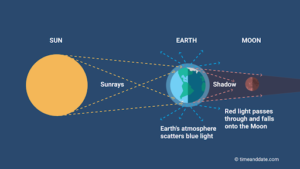In news– The first lunar eclipse of 2022 that begins on May 16 will only be visible in the western hemisphere across Americas, Europe, Africa and not in India.
What is blood moon?
- Blood Moon is not a scientific term, though in recent times it is being widely used to refer to a total lunar eclipse because a fully eclipsed Moon often takes on a reddish color.
- While the moon will be immersed in the earth’s shadow, the red wavelengths of sunlight filter through Earth’s atmosphere, falling on the moon’s surface.

- A total lunar eclipse happens when the Moon travels through the Earth’s umbra and blocks all direct sunlight from illuminating the Moon’s surface.
- However, some sunlight still reaches the lunar surface indirectly, via the Earth’s atmosphere, bathing the Moon in a reddish, yellow, or orange glow.
- As the Sun’s rays pass through the atmosphere, some colors in the light spectrum—those towards the violet spectrum—are filtered out by a phenomenon called Rayleigh scattering (This is the same mechanism that causes colorful sunrises and sunsets).
- Red wavelengths are least affected by this effect, so the light reaching the Moon’s surface has a reddish hue, causing the fully eclipsed Moon to take on a red color.
- Depending on the composition of the atmosphere, different parts of the light spectrum are filtered out, so the Moon may also look yellow, orange, or brown during a total lunar eclipse.
- The term Blood Moon is also sometimes used to refer to four total lunar eclipses that happen in the span of two years, a phenomenon astronomers call a lunar tetrad.
- The eclipses in a tetrad occur about six months apart with five uneclipsed Full Moons between them.
- The 2014–2015 lunar tetrad gathered a lot of attention because of claims by some religious organizations that the eclipses in the tetrad were a sign of the end times.
- The current century 2001 to 2100 will have eight tetrads.
- The first tetrad of the 21st century took place in 2003-2004, the second was in 2014–2015, and the next will be in 2032–2033.
Source: Business Insider














